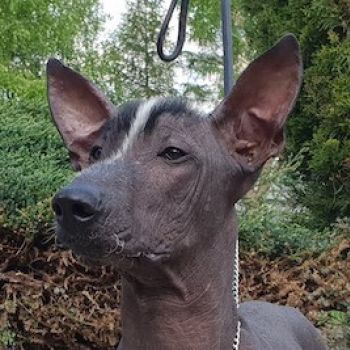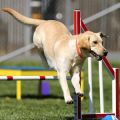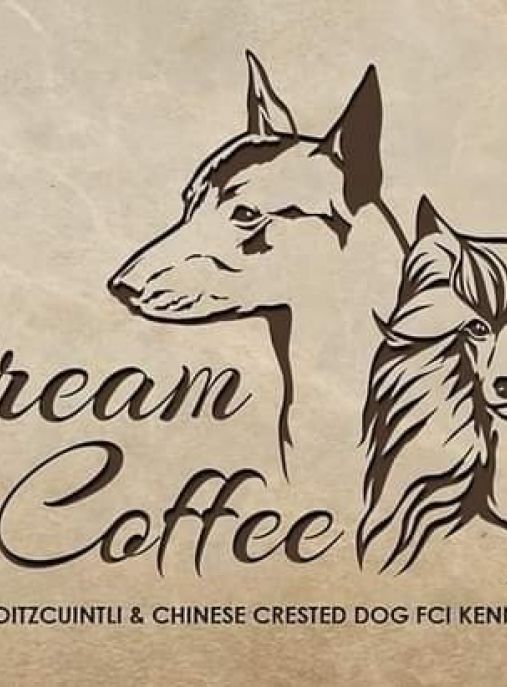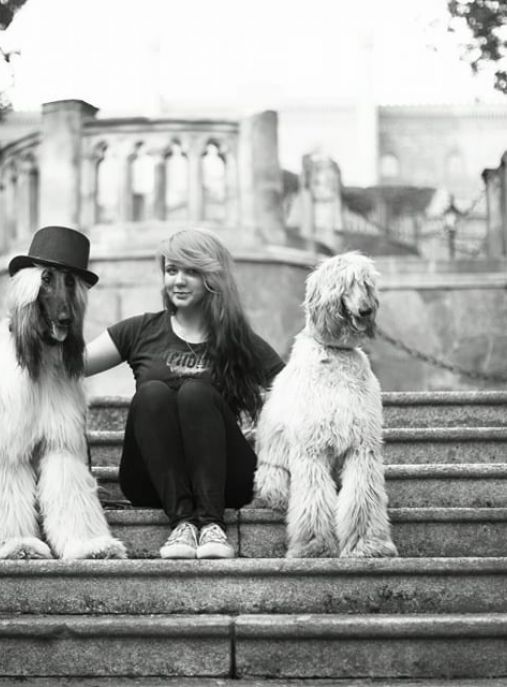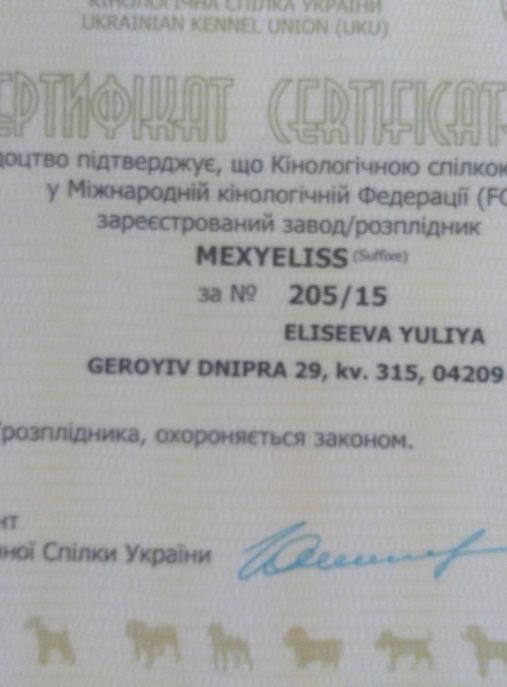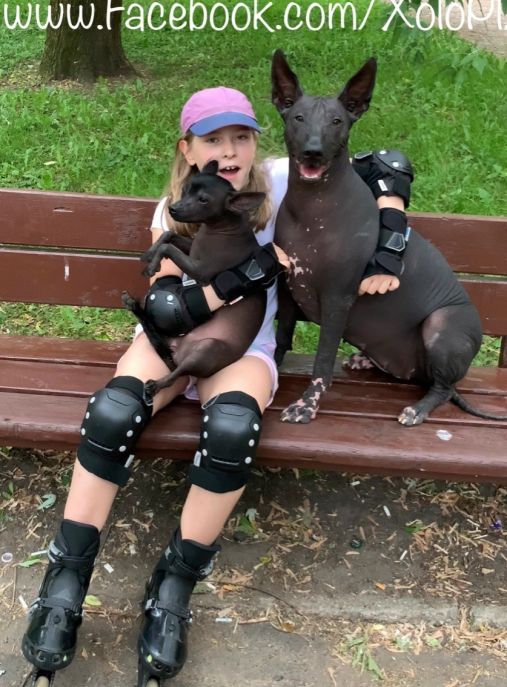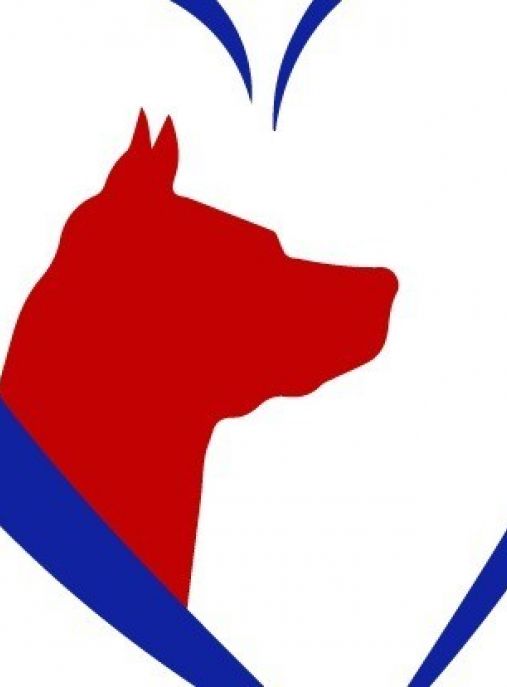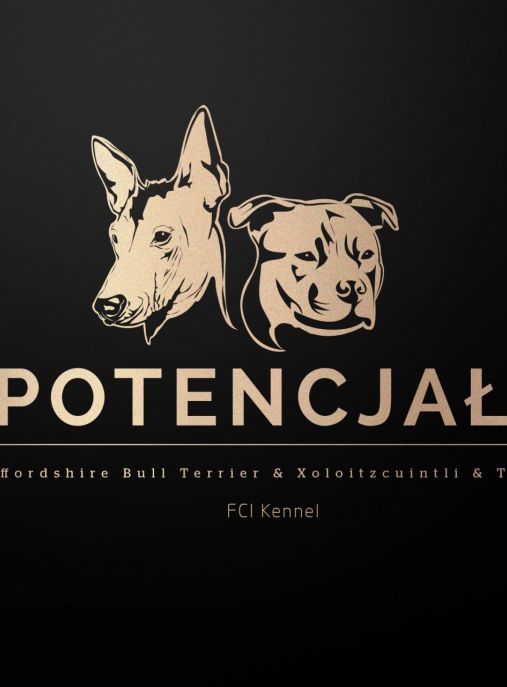The Xoloitzcuintle Standard, also known as the Mexican Hairless Dog, is a unique and ancient breed that holds a special place in Mexican culture. With its distinctive appearance and fascinating history, the Xoloitzcuintle Standard has become a beloved companion and a symbol of Mexican heritage.
The Xoloitzcuintle Standard is a medium-sized dog with a lean and muscular build. Its most distinguishing feature is its lack of hair, although some individuals may have a short, smooth coat. The skin of the Xoloitzcuintle Standard is typically dark and can range from black to gray to bronze. This breed has a noble and elegant appearance, with a wedge-shaped head, almond-shaped eyes, and large, erect ears.
The history of the Xoloitzcuintle Standard dates back thousands of years to pre-Columbian times in Mexico. It is believed to be one of the oldest dog breeds in the world, with evidence of its existence dating back over 3,000 years. The Xoloitzcuintle Standard was highly revered by the ancient Aztecs and Mayans, who believed it possessed mystical and healing powers. It was often depicted in ancient artwork and was even considered a sacred animal.
According to the FCI (Fédération Cynologique Internationale) typology, the Xoloitzcuintle Standard belongs to Group 9 - Companion and Toy Dogs. This group includes small to medium-sized dogs that are primarily kept as companions and are known for their friendly and affectionate nature. The Xoloitzcuintle Standard fits perfectly into this category, as it is known for its loyalty, intelligence, and strong bond with its human family.
The Xoloitzcuintle Standard is a versatile breed that can adapt to various lifestyles and living conditions. It is an excellent choice for individuals or families looking for a devoted and loving companion. This breed thrives on human interaction and craves attention, making it an ideal choice for those who can provide ample time and affection. The Xoloitzcuintle Standard is also known for its protective nature, making it a great watchdog.
In terms of size, the Xoloitzcuintle Standard typically weighs between 20 to 30 pounds (9 to 14 kilograms) and stands at a height of 16 to 23 inches (41 to 58 centimeters) at the shoulder. However, it is important to note that there can be some variation in size within the breed. The life expectancy of the Xoloitzcuintle Standard is around 12 to 14 years, although with proper care and nutrition, some individuals have been known to live even longer.
One interesting fact about the Xoloitzcuintle Standard is its unique ability to regulate body temperature. Due to its lack of hair, this breed is highly sensitive to temperature changes and can feel hot or cold to the touch. To compensate for this, the Xoloitzcuintle Standard has a higher body temperature than most dogs, which helps it stay warm in cooler climates. Additionally, this breed is known for its exceptional agility and speed, making it a great candidate for various dog sports and activities.
In conclusion, the Xoloitzcuintle Standard is a remarkable breed with a rich history and a distinct appearance. Its ancient roots and cultural significance make it a cherished symbol of Mexican heritage. With its loyal and affectionate nature, the Xoloitzcuintle Standard is a wonderful companion for those who appreciate its unique qualities and are willing to provide the love and care it deserves.
The Xoloitzcuintle Standard, also known as the Mexican Hairless Dog, is a unique and ancient breed with a fascinating character. These dogs possess a distinct personality that sets them apart from other breeds. With their loyal and affectionate nature, they make wonderful companions for the right owner.
The character of Xoloitzcuintle Standard dogs can be described as intelligent, alert, and highly adaptable. They are known for their strong bond with their human family and are often referred to as "Velcro dogs" due to their tendency to stick close to their loved ones. This breed thrives on human interaction and craves attention, making them excellent family pets.
One notable trait of Xoloitzcuintle Standards is their calm and gentle demeanor. They are generally well-behaved and rarely display aggressive behavior. However, they can be reserved and cautious around strangers, which makes them excellent watchdogs. With proper socialization from an early age, they can learn to be more accepting of new people and situations.
When it comes to training, Xoloitzcuintle Standards are intelligent and eager to please. They respond well to positive reinforcement techniques, such as treats and praise. Consistency and patience are key when training these dogs, as they can be sensitive to harsh or forceful methods. Early socialization and obedience training are essential to ensure they grow up to be well-rounded and obedient companions.
Exercise is crucial for Xoloitzcuintle Standards to maintain their physical and mental well-being. While they are not excessively energetic, they still require regular walks, playtime, and mental stimulation. These dogs enjoy participating in various activities, such as agility, obedience, and even therapy work. Engaging them in these activities not only keeps them physically fit but also strengthens the bond between the dog and its owner.
Grooming the Xoloitzcuintle Standard is relatively easy due to their hairless or coated variety. Hairless Xolos require regular skincare to protect their sensitive skin from sunburn and dryness. Applying sunscreen and moisturizers, as well as providing them with appropriate clothing during extreme weather conditions, is essential. Coated Xolos have a short, dense coat that requires minimal grooming, such as regular brushing to remove loose hair.
Raising a Xoloitzcuintle Standard puppy requires a loving and patient approach. Early socialization is crucial to ensure they grow up to be well-adjusted adults. Introduce them to various people, animals, and environments to help them become confident and adaptable. Providing them with a safe and stimulating environment, along with consistent training and positive reinforcement, will help them develop into well-behaved and happy dogs.
In conclusion, the Xoloitzcuintle Standard is a remarkable breed with a unique character. Their loyalty, affection, and adaptability make them excellent family pets. With proper training, socialization, and care, these dogs can thrive and bring joy to their owners' lives. If you are looking for a loving and intelligent companion, the Xoloitzcuintle Standard might be the perfect breed for you.
The Xoloitzcuintle, also known as the Mexican Hairless Dog, is a unique and ancient breed that requires specific care to ensure their well-being. Here are some tips on how to properly care for Xoloitzcuintle Standard dogs, including what to do and what not to do:
1. Grooming: Xoloitzcuintles come in three varieties - hairless, coated, and intermediate. Hairless Xolos require regular skincare to protect their sensitive skin from sunburn, dryness, and irritation. Apply sunscreen when going outside and moisturize their skin with pet-safe lotions. Coated and intermediate Xolos need regular brushing to prevent matting and to keep their coats healthy.
2. Exercise: Xolos are an active breed that requires regular exercise to maintain their physical and mental well-being. Daily walks, playtime, and interactive toys are essential to keep them stimulated. However, be cautious not to overexert them in extreme weather conditions, as they are prone to overheating and sunburn.
3. Nutrition: Provide a balanced and nutritious diet to your Xoloitzcuintle. Consult with a veterinarian to determine the appropriate portion sizes and the best type of food for your dog's age, size, and activity level. Avoid overfeeding, as Xolos can be prone to weight gain, which can lead to health issues.
4. Dental Care: Like all dogs, Xolos require regular dental care. Brush their teeth regularly using a dog-specific toothbrush and toothpaste to prevent dental diseases. Additionally, provide them with dental chews or toys to help keep their teeth clean and healthy.
5. Socialization: Xolos are known for their loyalty and affection towards their families. However, they can be reserved or wary of strangers. Early and consistent socialization is crucial to ensure they are well-adjusted and comfortable in various situations. Expose them to different people, animals, and environments from a young age to help them develop into confident and well-behaved dogs.
6. Training: Xolos are intelligent and eager to please, making them relatively easy to train. Use positive reinforcement techniques such as treats, praise, and play to motivate and reward good behavior. Consistency, patience, and firm but gentle guidance are key to successful training sessions.
7. Health Care: Regular veterinary check-ups are essential to monitor your Xoloitzcuintle's overall health. Vaccinations, parasite prevention, and routine examinations should be part of their healthcare regimen. Additionally, be aware of breed-specific health concerns such as dental issues, skin allergies, and hip dysplasia. Promptly address any signs of discomfort or illness by seeking veterinary care.
What NOT to do:
1. Do not leave your Xoloitzcuintle alone for extended periods. They thrive on companionship and can develop separation anxiety if left alone for too long.
2. Do not expose your hairless Xolo to extreme temperatures without protection. They are susceptible to both cold and hot weather, so provide appropriate clothing or shelter when necessary.
3. Do not neglect their dental care. Poor oral hygiene can lead to serious health issues, including tooth loss and infections.
4. Do not use harsh training methods or punishment. Xolos respond best to positive reinforcement techniques, and using force or fear can damage their trust and lead to behavioral problems.
5. Do not overfeed your Xoloitzcuintle. Obesity can lead to various health issues, including joint problems and heart disease. Stick to a balanced diet and avoid excessive treats.
Remember, each Xoloitzcuintle is unique, and their care may vary slightly depending on their individual needs. Always consult with a veterinarian or a professional dog trainer for personalized advice and guidance to ensure the best care for your beloved Xoloitzcuintle Standard dog.
The Xoloitzcuintle Standard, also known as the Mexican Hairless Dog, is a unique and ancient breed that possesses a captivating range of colors. However, the most common color seen in Xoloitzcuintle Standard dogs is a stunning shade of black.
The black coloration of these dogs is truly striking and adds to their overall allure. It is a deep, rich black that exudes elegance and sophistication. The coat of the Xoloitzcuintle Standard is typically smooth and sleek, which further enhances the beauty of the black color.
The black hue of these dogs is not just limited to their fur; it extends to their skin as well. One of the distinctive features of the Xoloitzcuintle Standard is its hairlessness, which allows its black skin to be visible. This gives the dog a unique and eye-catching appearance, as the contrast between the black skin and the black fur creates a visually appealing effect.
The black color of the Xoloitzcuintle Standard is not uniform throughout its body. It often exhibits variations in shade, with some areas appearing slightly lighter or darker than others. These subtle variations add depth and dimension to the dog's overall appearance, making it even more captivating.
In addition to the black color, Xoloitzcuintle Standard dogs may also have small patches of white or gray on their bodies. These patches can be found on the chest, paws, or even on the face. While these patches are not as common as the black color, they provide a delightful contrast and further enhance the dog's unique beauty.
The black color of the Xoloitzcuintle Standard is not only aesthetically pleasing but also holds cultural significance. In ancient Mexican civilizations, black was considered a sacred color and was associated with various deities and rituals. The Xoloitzcuintle Standard, being a breed deeply rooted in Mexican history, carries this symbolism with pride.
In conclusion, the common color of Xoloitzcuintle Standard dogs is a captivating shade of black. This deep, rich black color, combined with their hairlessness and unique variations, makes these dogs truly mesmerizing. Whether it's their smooth black fur or their striking black skin, the Xoloitzcuintle Standard's coloration is a testament to their beauty and cultural significance.
The Xoloitzcuintle Standard, also known as the Mexican Hairless Dog, is a unique and ancient breed that boasts a remarkable health profile. These dogs are generally robust and hardy, with a life expectancy of 12 to 14 years. However, like all breeds, they are prone to certain health issues that owners should be aware of in order to provide the best care for their beloved pets.
One of the most common health concerns in Xoloitzcuintles is dental problems. Due to their lack of hair, these dogs often have fewer teeth than other breeds, and their remaining teeth may be misaligned or prone to decay. Regular dental care, including brushing their teeth and providing appropriate chew toys, is essential to maintain their oral health.
Another condition that Xoloitzcuintles may be predisposed to is skin problems. Their hairless nature makes them more susceptible to sunburn, dry skin, and skin infections. It is crucial to protect their skin from harmful UV rays by applying pet-safe sunscreen and providing shade during sunny days. Regular moisturizing and bathing with gentle, hypoallergenic shampoos can help keep their skin healthy and prevent dryness or irritation.
Xoloitzcuintles are also known to have a higher risk of developing allergies. These allergies can manifest as food allergies, environmental allergies, or even contact allergies. Owners should carefully monitor their dog's diet, ensuring it is free from common allergens such as grains, artificial additives, or certain proteins. If allergies are suspected, a veterinarian can conduct allergy testing to identify the specific triggers and recommend an appropriate diet or treatment plan.
Like many medium to large-sized breeds, Xoloitzcuintles can be prone to hip dysplasia. This condition occurs when the hip joint does not develop properly, leading to pain, lameness, and arthritis. Regular exercise on soft surfaces, maintaining a healthy weight, and providing joint supplements can help reduce the risk and manage the symptoms of hip dysplasia.
Additionally, Xoloitzcuintles may be susceptible to certain genetic conditions such as progressive retinal atrophy (PRA) and patellar luxation. PRA is a degenerative eye disease that can lead to blindness, while patellar luxation refers to the dislocation of the kneecap. Regular eye examinations and monitoring for any signs of vision loss are crucial, and surgical intervention may be necessary for severe cases of patellar luxation.
To ensure the overall health and well-being of Xoloitzcuintles, regular veterinary check-ups are essential. These visits allow for early detection of any potential health issues and provide an opportunity for preventive care, such as vaccinations, parasite control, and routine blood work.
In addition to veterinary care, a balanced diet tailored to the Xoloitzcuintle's specific needs is crucial. High-quality dog food, preferably formulated for medium to large breeds, should be provided, taking into account their age, activity level, and any specific dietary requirements. Fresh water should always be available, and portion sizes should be monitored to prevent obesity, which can exacerbate certain health conditions.
Regular exercise is vital for the physical and mental well-being of Xoloitzcuintles. Daily walks, play sessions, and mental stimulation activities help prevent obesity, promote cardiovascular health, and prevent behavioral issues that may arise from boredom or pent-up energy.
In conclusion, while the Xoloitzcuintle Standard is generally a healthy breed, owners should be aware of potential health concerns such as dental problems, skin issues, allergies, hip dysplasia, and genetic conditions. By providing proper dental care, protecting their skin, monitoring their diet, and ensuring regular veterinary check-ups, owners can help maintain the health and happiness of their Xoloitzcuintle companions for years to come.
The Xoloitzcuintle Standard, also known as the Mexican Hairless Dog, is a unique and ancient breed that requires specific nutritional care to maintain optimal health and well-being. This breed is known for its elegance, intelligence, and overall good health. To ensure the Xoloitzcuintle Standard dogs thrive, it is crucial to provide them with a well-balanced diet that meets their nutritional needs.
Protein is an essential component of a Xoloitzcuintle Standard's diet. High-quality animal-based proteins such as chicken, turkey, beef, or fish should form the foundation of their meals. These proteins provide the necessary amino acids for muscle development, tissue repair, and overall growth. It is advisable to choose lean cuts of meat and remove any excess fat to prevent weight gain and maintain a healthy body condition.
In addition to protein, Xoloitzcuintle Standard dogs require a moderate amount of healthy fats. Fats are a concentrated source of energy and aid in the absorption of fat-soluble vitamins. Incorporating omega-3 fatty acids, found in fish oil or flaxseed oil, can promote a healthy coat and skin, reduce inflammation, and support cardiovascular health. However, it is important to avoid excessive fat intake, as it can lead to obesity and related health issues.
Carbohydrates are another crucial component of a Xoloitzcuintle Standard's diet. Opt for complex carbohydrates such as whole grains, sweet potatoes, and legumes. These provide a steady release of energy, fiber for digestive health, and essential vitamins and minerals. Avoid refined grains and sugary treats, as they can cause spikes in blood sugar levels and contribute to weight gain.
Fruits and vegetables should also be included in a Xoloitzcuintle Standard's diet. These provide essential vitamins, minerals, and antioxidants that support overall health and boost the immune system. Some suitable options include carrots, spinach, blueberries, and apples. However, it is important to avoid toxic foods such as grapes, raisins, onions, and garlic, as they can be harmful to dogs.
Feeding guidelines for Xoloitzcuintle Standard dogs may vary depending on their age, weight, activity level, and overall health. It is recommended to consult with a veterinarian to determine the appropriate portion sizes and feeding frequency. Generally, dividing their daily food intake into two or three meals is preferable to prevent digestive issues and maintain stable blood sugar levels.
While providing a balanced diet is crucial, it is equally important to ensure access to fresh, clean water at all times. Hydration is essential for proper digestion, nutrient absorption, and overall organ function.
Avoid feeding Xoloitzcuintle Standard dogs with table scraps, processed foods, and excessive treats. These can lead to weight gain, nutrient imbalances, and potential health issues. Additionally, certain foods such as chocolate, caffeine, alcohol, and avocados should never be given to dogs, as they can be toxic.
In conclusion, the nutrition of Xoloitzcuintle Standard dogs should consist of high-quality proteins, moderate amounts of healthy fats, complex carbohydrates, fruits, and vegetables. Portion control, feeding frequency, and access to fresh water are essential. Avoiding toxic foods and limiting processed treats will help maintain their overall health and longevity. Remember, consulting with a veterinarian is always recommended to tailor the diet to the specific needs of your Xoloitzcuintle Standard dog.

